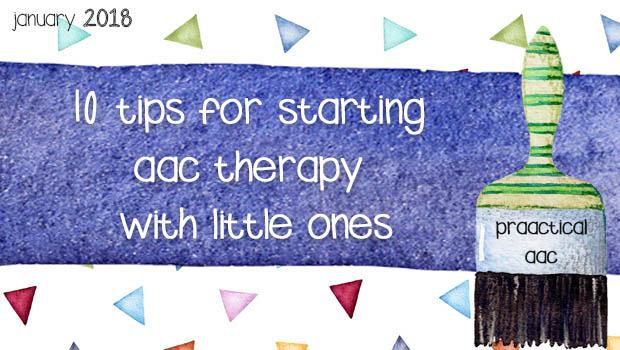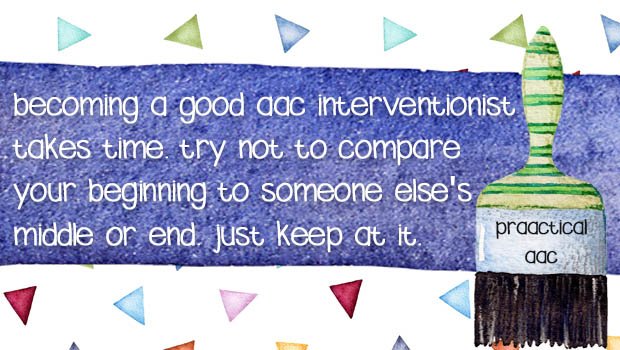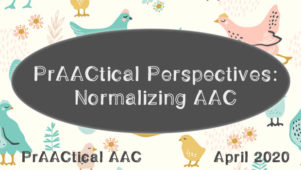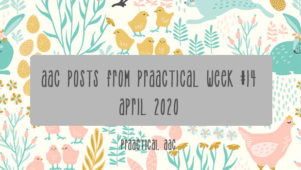10 Tips for Starting AAC Therapy with Little Ones

It’s exciting to see so many graduate student SLPs and new graduates who are interested in working with people with AAC needs. We hear from them frequently with questions about how to be effective in their therapy and the practical aspects of running a good therapy session. Here are some tips we frequently share with those who are starting to implement AAC with young children.
- Use a visual schedule for every session. The operative word there is ‘use.’ Making a schedule for our therapy is a great start, but unless we really use the schedule all throughout the session, it’s unlikely to provide many benefits. Go to it as soon as you get into the room, AND before and after every activity. (For those who are interested, there is more on making and effectively implementing visual schedules here.
- Trust the process. You will need to do this at least 4-8 times before your kiddo starts to get the hang of it but eventually, this will help all the sessions run more smoothly.
- Just keep at it. Make changes to the schedule, when needed, as you put it into practice and begin to spot where improvements would be helpful. For example, if the child really struggles with putting an activity symbol in the ‘finished’ envelope, we might swap that out and use a basket or bin instead.
- Start and end with the same activity every time. This builds predictability and understanding, both of which help children grasp what to expect and what is expected of them. For example, when working with little children, we can do a hello/goodbye song with interactive components. We might find or make up a SIMPLE song like this: Hello (name). Hello (name). Hello (name). It’s time to say hello. Music is powerful, fun, and family-friendly!
- When you sing, have a visual support with the lyrics to the song. You also need some way to ‘say’ the names of the people in the session (e.g., photos of the child, mom, dad, and you in their AAC system or, if that isn’t possible, use a choice board).
- Give the child a choice of who to sing to first. Sing to that person, then repeat with additional choices. (If the child, mom, and I are all in the session, we sing three verses of the song.)
- Pause as you sing so that we can elicit the name/picture of the person we’re singing to. Hello [pause while child and you point to the picture]
- Substitute goodbye for hello and you have your goodbye song. (See? This doesn’t need to be complicated.)
- Have lots of short activities (3-5 min). For a 30-min session, you might have the hello and goodbye songs (every time) and 4-5 other activities. Each activity has a picture on the schedule, and you should aim to start and end every single activity at the schedule. Make sure there is a clear way for the kid to indicate when the activity is finished.
It’s usually better to have materials on hand for 2-3 more activities than you think you will have time for. That way, if a planned activity doesn’t interest the child, you can wrap it up quickly and add one of your backup activities. You may never need those backup materials, but it will reduce your anxiety and give you the freedom to abandon things that don’t engage the child when that seems appropriate.
- Activities: Choosing or developing activities depends on what the specific goals are. Often, we choose to have some activities that repeat every session and some that are new or less familiar. This helps build their tolerance of new things, which is a challenge for some learners, but also builds enough familiarity so that children understand the expectation and can focus on the target skills.
- Toy suggestions: bubbles, wind-up toys, books (every session even when this is not preferred by the kid b/c we have to teach him how to like reading with adults), a SIMPLE iPad game (e.g., Peek A Boo Fridge/Barn, Stop and Go), toys where you release a car, ball, or something at the top and it goes down a track or tunnel and comes out at the bottom, a simple version of corn hole, Nerf basketball. Remember that if you are using a play or learning app on an iPad or other mobile device, that should be on a different device and not on the one that you or the child are using for communication.
- Create a session that has a balance of experiences: easy and hard, sitting and moving.
- Easy and Hard: Sessions that require children to work at the top of their skill level for the whole time will be frustrating. Sessions that only allow the student to practice what they already know aren’t powerful.
- Sitting and Moving: Children are made to move but lots of good AAC learning can also happen with tabletop activities. Alternate activities where children are sitting on the floor/in a chair with those where they are using their bodies and moving around. This honors their physiology and also builds their tolerance for sitting, attending, and learning.
- Whenever possible, include the family in all sessions even though you may not feel confident in your AAC teaching. Make them a partner in your problem-solving. Some may tell you that the child ‘does better’ without them but that completely misses the point. The point of therapy is not to perform but to learn. You and mom/dad will figure out together how to maximize the learning. You may feel nervous at first but the gains that you will make in using this approach will give this kid the best chances for real progress.
- The #1 most critical strategy for you to consistently implement is aided language input. It will take awhile. but without that learning will be very, very limited. More on aided language input here.
Once you are comfortable with that and are implementing it throughout the session, then challenge yourself to add more strategies. For now, though, give yourself as many opportunities as possible to become proficient at using aided language input.
- Consider giving the child access to a robust AAC system. There are many of them to choose from and often these children need and can handle more than most people think. Do what you can to help the team not underestimate their potential.
- Share resources with families and other service providers. Children will be most successful when we can influence others to use supportive AAC strategies. In addition to our direct work with families, most will also benefit from specific guidance as to what sorts of things they can do at home to extend the AAC learning throughout the week. Here are some great parent handouts and home activities to explore,
- Learn to be gentle with yourself. Accept that it will take awhile to become proficient in the AAC strategies, behavior management, and clinical/educational skills that you’ll need to be effective. It takes time. How much time? That depends on how often you practice these skills. The more you do, the faster you’ll get good at it. So don’t let fear of looking silly or not doing it right hold you back. Make a commitment to your own clinical/educational growth and just keep at it. Ask for feedback when you feel brave and encouragement when you feel low. Keep reminding yourself that it’s all worth it in the end. You went into this field to make a difference and these are critical steps in that journey. Be gentle with yourself and just keep taking the next steps. You are not the only one who has struggled (we ALL have and many of us STILL DO). You are not alone.
Do you have top tips for new therapists and educators? We’d love to hear about them.
Filed under: Featured Posts, PrAACtical Thinking
Tagged With: AAC implementation, early intervention, preschool, therapy
This post was written by Carole Zangari





6 Comments
Hi Carole
Thank you for your wonderful work on this.
I wonder what tips for working with adults would look like?
Very practical tips
please use s2c it gives a more effective and reliable voice
s2c will give oppernuties and is a great example of being able to handle more
s2c is powerful please use it i agree with aa and allie
tip don’t limit a child to just speech even if yo think they don’t need aac